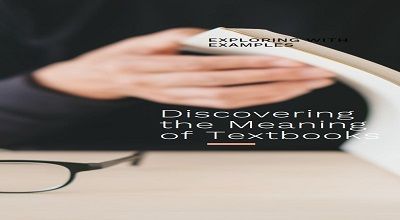Textbooks Books
It seems like you’re asking about the meaning of the phrase “textbooks books with examples.” However, the phrase you provided appears to be a bit confusing and may not convey a clear message. Let’s break it down:
- “Textbooks” usually refer to educational books used in formal education settings to teach a particular subject or topic.
- “Books” are written or printed works that can cover a wide range of topics and genres.
- “With examples” suggests that the books in question include illustrative examples to help explain or clarify the content.
- It’s possible that you’re trying to inquire about textbooks that include examples to aid in learning and understanding a subject. In that case, the phrase could be better expressed as “Textbooks with examples.”
Examples…
Textbooks with examples are instructional materials commonly used in education. They typically provide theoretical explanations of concepts and then reinforce these explanations with practical examples to help students grasp the content better. These examples can be in the form of exercises, case studies, sample problems, or real-world applications related to the subject matter.
What are the Parts of a Textbook?
A typical textbook is structured into various parts and sections. Each serves a specific purpose to facilitate learning and comprehension. While the specific organization may vary depending on the subject and the author’s preferences. Here are the common parts you can expect to find in a textbook:
Front Matter:
- Title Page: Includes the book’s title, subtitle, author(s), publisher, and often an image or graphic.
- Copyright Page: Contains copyright information, publication details, ISBN (International Standard Book Number), and legal notices.
- Table of Contents: Lists the chapters or major sections of the book along with their page numbers, allowing readers to navigate the content easily.
- List of Figures and Tables: Provides a reference to visual aids and tables used within the book.
- Preface or Foreword: An introduction or forward-looking statement from the author or an expert in the field explaining the book’s purpose, scope, and relevance.
- Acknowledgments: Recognizes individuals or organizations who contributed to the book’s creation.
Body of the Text:
- Chapters: The main content of the textbook is divided into chapters. Each focuses on a specific topic or aspect of the subject matter.
- Subsections: Chapters are often further divided into subsections and sections. And subheadings to organize the content and make it more digestible.
- Text: This is where the core information and explanations are provided, accompanied by illustrations, diagrams, and examples.
Back Matter:
- Appendices: Additional supplementary material, such as tables, charts, graphs, and extended explanations. Reference materials may be included in the appendices.
- Glossary: A list of key terms and their definitions used in the book, aiding readers in understanding technical or specialized terminology.
- Bibliography or References: A list of sources and references cited throughout the book. Providing credibility and allowing readers to explore further.
- Index: An alphabetical list of keywords, topics, and page numbers, enabling readers to quickly locate specific information within the book.
End Matter:
- Endnotes or Footnotes: Explanatory or citation notes that provide additional context or references to specific points in the text.
- Further Reading: Suggestions for additional readings, books, and articles. Or resources related to the subject matter.
Final Words
In summary, “textbooks with examples” are educational books designed to teach. A subject by providing theoretical knowledge along with practical illustrations. Or instances to enhance comprehension and retention. Some textbooks may include access to online resources, companion websites, or supplemental materials like multimedia content, practice quizzes, or interactive simulations.
These parts work together to make the textbook a comprehensive and effective tool for teaching and learning. They provide structure, context, references, and aids to enhance the educational experience and support the objectives of the book. Keep in mind that the specific content and layout may vary from one textbook to another. But these elements are commonly found in educational Textbooks.
